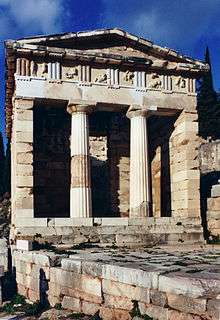Treasury

A treasury is either
- A government department related to finance and taxation.
- A place or Schatzkammer where currency or precious items (gold, diamonds, etc.) is/are kept.
The head of a treasury is typically known as a treasurer. This position may not necessarily have the final control over the actions of the treasury, particularly if they are not an elected representative.
The adjective for a treasury is normally "treasurial". The adjective "tresorial" can also be used, but this normally means pertaining to a treasurer.
History

[1] As of the definition of a treasury from thêsaurus and in the context of the treasure obtained from war efforts the first recorded booty in history is a stele taken during 1160 BC.[2][3][4][5][6][7][8]
The earliest found artefacts made of silver and gold are from Lake Varna in Bulgaria dated 4250–4000 BC,[9][10] the earliest of copper are dated 9000–7000 BC.[11]
...And there was also silver weighing many thousands of talents and all the royal treasure amounting to a very great sum...
The term treasury was first used in Classical times to describe the votive buildings erected to house gifts to the gods, such as the Siphnian Treasury in Delphi or many similar buildings erected in Olympia, Greece by competing city-states to impress others during the ancient Olympic Games. In Ancient Greece treasuries were almost always physically incorporated within religious buildings such as temples, thus making state funds sacrosanct and adding moral constraints to the penal ones to those who would have access to these funds.
The sovereigns' treasury within the palace in ancient Jerusalem, is considered to be similar in nature to the temple treasury.[13] The temple treasury of the settlement had appointed officials and functioned akin to a bank.[14]
... in fact, practically in every city there are banking places for the holy money ...
In excavations of Persopolis a text containing information pertaining to the activities of a temple treasury were discovered dated to the fifth century BC. The texts written in the Elamite language name the treasurer as ganzabara [16][17][18]
The ancient Roman word aerarium signified the treasury of the Senate, fiscus was used to indicate the imperial treasury used by Caesar.[19] [20]
Examples of treasuries
Treasury
In the United Kingdom, Her Majesty's Treasury is overseen by the Chancellor of the Exchequer. The traditional honorary title of First Lord of the Treasury is held by the Prime Minister. Her Majesty's Revenue and Customs administers the taxation system.
In the United States, the Treasurer reports to an executive-appointed Secretary of the Treasury. The IRS is the revenue agency of the US Department of the Treasury.
Ministry of finance
In many other countries, the treasury is called the "ministry of finance" and the head is known as the finance minister. Examples include Bangladesh, Belgium, Spain, Italy, New Zealand, Ghana, Canada, Malaysia, Singapore, India, Japan, the Netherlands, and Pakistan, Zimbabwe.
Both
In some other countries, a "Treasury" will exist alongside a separate "Ministry of Finance", with divided functions.
The government of Poland includes the Ministry of Finance as well as the Ministry of State Treasury, as does the government of Ukraine. It was the same in Italy before the creation of the united Ministry of Economy.
In the Australian federal government a treasurer and a finance minister co-exist. The Department of the Treasury is responsible for drafting the government budget, economic policy (except monetary policy), some market regulation and revenue policy (which is administered by the Australian Taxation Office). The Finance Minister, who manages the Department of Finance and Deregulation, is responsible for budget management, government expenditure and market deregulation.
Literary treasury
In a text known as the gnostic bible, dated some-what uncertainly to centuries about the 4th BC, the Pistis Sophia apparently describes treasuries of punishment, of which there are twelve.[21][22][23][24]
See also
References
- ↑ W J Hamblin – Warfare in the Ancient Near East to 1600 BC: Holy Warriors at the Dawn of History Taylor & Francis, 12 Apr 2006 Retrieved 2012-07-07 ISBN 0415255880
- ↑ R L Poole – The Exchequer in the Twelfth Century The Lawbook Exchange, Ltd., 1 Jan 2006 ISBN 1584776587 Retrieved 2012-06-25
- ↑ T Wardle – The Jerusalem Temple and Early Christian Identity Mohr Siebeck, 22 nov. 2010 2012-06-15
- ↑ R T Neer – Framing the Gift: The Politics of the Siphnian Treasury at Delphi Retrieved 2012-06-16
- ↑ Thomas Dudley Fosbroke, Dionysius Lardner. A treatise on the arts, manufactures, manners, and institutions of the Greeks and Romans, Volume 1. Longman, Rees, Orme, Brown, Green & Longman, and John Taylor, 1833.
- ↑ K Roberts. The Origins of Business, Money, and Markets. Columbia University Press, 28 June 2011. ISBN 0231153260. Retrieved 2012-06-16.
- ↑ L Rothfield – The Rape of Mesopotamia: Behind the Looting of the Iraq Museum University of Chicago Press, 1 Apr 2009 Retrieved 2012-07-07 ISBN 0226729451
- ↑ D Harper – etymology online Retrieved 2012-07-07
- ↑ S La Niece – Gold Harvard University Press, 15 Dec 2009 Retrieved 2012-04-10 ISBN 0674035909
- ↑ T Mohide – The International Silver Trade Woodhead Publishing, 28 Jul 1992 Retrieved 2012-07-05 ISBN 1855730677
- ↑ I McNeil – An Encyclopaedia of the History of Technology Taylor & Francis, 2 Feb 1990 Retrieved 2012-07-05 ISBN 0415013062
- ↑ L Fargo Brown, G Barr Carson – Men and Centuries of European Civilization Ayer Publishing, 1971 Retrieved 2012-04-10 ISBN 0836921003
- ↑ M Haran – Temples and Temple-service in Ancient Israel̈: An Inquiry Into Biblical Cult Phenomena and the Historical Setting of the Priestly School Eisenbrauns, 1977 Retrieved 2012-07-03 ISBN 0931464188
- ↑ T Wardle – The Jerusalem Temple and Early Christian Identity Mohr Siebeck, 22 Nov 2010 Retrieved 2012-07-04 ISBN 3161505689
- ↑ M E Stevens – Temples, Tithes, and Taxes: The Temple and the Economic Life of Ancient Israel Baker Academic, 1 Nov 2006 Retrieved 2012-07-04 ISBN 0801047773
- ↑ Hugh G. M. Williamson – Studies In Persian Period History and Historiography Mohr Siebeck, 2004 Retrieved 2012-07-04 ISBN 3161482611
- ↑ J Boardman – The Cambridge Ancient History: Persia, Greece and the Western Mediterranean c. 525 to 479 B.C. Cambridge University Press, 24 Nov 1988 Retrieved 2012-07-04 ISBN 0521228042
- ↑ D T Potts- The Archaeology of Elam: Formation and Transformation of an Ancient Iranian State Cambridge University Press, 29 Jul 1999 Retrieved 2012-07-04 ISBN 0521564964
- ↑ L Adkins, R A Adkins – Handbook to Life in Ancient Rome Oxford University Press, 16 Jul 1998 Retrieved 2012-07-04 ISBN 0195123328
- ↑ Sir William Smith – Dictionary of Greek and Roman Antiquities C.C. Little and J. Brown, 1853 Retrieved 2012-07-04
- ↑ G. R. S. Mead – Pistis Sophia Kessinger Publishing, 1 Jan 1992 Retrieved 2012-07-04 ISBN 0922802874
- ↑ S A Weor – The Gnostic Bible: The Pistis Sophia Unveiled Glorian Publishing, 1 Oct 2011 Retrieved 2012-07-04 ISBN 1934206814
- ↑ V MacDermot – The Cult of the Seer in the Ancient Middle East: A Contribution to Current Research on Hallucinations Drawn from Coptic and Other Texts University of California Press, 1971 Retrieved 2012-07-04 ISBN 0520020308
- ↑ (secondary) E S Sears – Running Through the Ages McFarland, 2001 Retrieved 2012-07-04 ISBN 0786409711
| Look up treasury in Wiktionary, the free dictionary. |